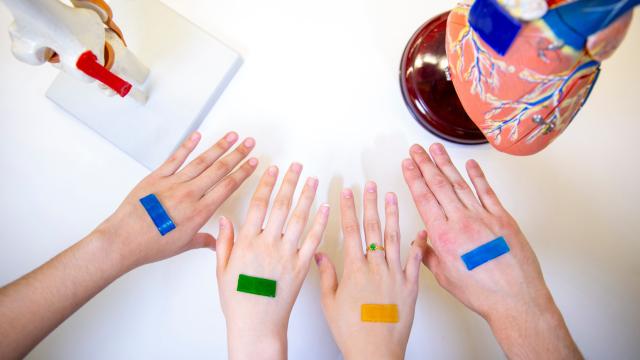Here’s a nifty if still early-in-development bit of science. This week, scientists at Harvard and elsewhere said they’ve created a novel type of dressing that could rapidly heal all sorts of wounds. The gel-based, heat-activated design was inspired by the Wolverine-like skin we have when we’re in the womb.
It’s well known that our fetal skin can completely regenerate itself when injured, without scarring. This happens, at least partly, because embryonic cells produce protein fibres that quickly and tightly close up and contract the skin surrounding a wound. As adults, our skin cells can still do this to an extent, but nowhere to the same degree.
The research team, which also includes scientists from McGill University in Canada, say they’ve found a way to coax our skin back into its younger self, healing-wise. The team’s work showcasing their design was published this week in Science Advances.
According to the study, the active adhesive dressings, as they’ve been called, are made out of “thermoresponsive tough adhesive hydrogels that combine high stretchability, toughness, tissue adhesion, and antimicrobial function.” The advanced adhesive material — stickier than what’s found in conventional wound dressings — is activated when exposed to body heat. They also contain silver nanoparticles, which have antimicrobial properties, to further boost healing.
In both pig and mouse skin, the dressings were shown to close wounds much faster than traditional bandages, while reducing the time it took for them to heal. They also appeared to cause no inflammation or immune system response, indicating their safety on living tissue. And in a computer model created by the team, the dressings were projected to have a similar wound-closing effect on human skin as they did on mice, suggesting they’d be just as effective.
The team expects that these dressings could be used not just for nasty cuts and scrapes, but more difficult-to-treat skin injuries like ulcers, and the design could be modified for other medical purposes.
“This technology has the potential to be used not only for skin injuries, but also for chronic wounds like diabetic ulcers and pressure sores, for drug delivery, and as components of soft robotics-based therapies,” study author David Mooney, a bioengineer at Harvard’s John A. Paulson School for Engineering and Applied Sciences, said in a release from the university.
Of course, successful animal experiments and computer simulations are not a guarantee that these dressings will work for people. So human trials are undoubtedly needed. The authors said they plan to study whether their invention can work as well under a variety of medical scenarios and conditions, such as colder weather, which can affect the skin’s temperature.
